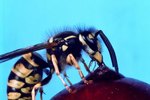
Several bees and wasps live underground, whether it's in sand, soil or mud. They may dig into fresh earth, or use existing holes and cracks in the ground. When it comes to hibernation, life-sustaining queen bees hibernate, while workers, drones and other colony members die as the winter approaches.
The Buzz About Bumblebees
These furry-looking bees with distinctive black and yellow stripes prefer to make their nests underground, and sometimes on the ground itself. In some cases, they use existing nests abandoned by mice or birds. Some species of bumblebees actually make their nests inside other bumblebee nests. These are known as parasitic bumblebees, and they lack the ability to make their own nests. Female bumblebees hibernate in the winter, and many other colony members die as the cold weather arrives.
Yellow Jacket Wasps Burrow
Yellow jacket wasps, also known simply as yellow jackets, make their nests underground. They may use tree hollows, cracks in wall buildings or cinder block fences. Yellow jackets generally build their nests from masticated wood pulp or leaf litter, or both. As with bumblebees, female yellow jackets hibernate. After the summer and fall mating seasons, the queens seek a place to hibernate, and the workers and drones die as the weather gets colder.
The Solitary Sand Wasps
Sand wasps are solitary wasps, unlike social bees and wasps who live in colonies. Female sand wasps do congregate to excavate underground tunnels as a team, and sometimes fly as a group to ward off predators. These wasps burrow under the sand, where they lay a single egg. They have the ability to paralyze their prey, and after they lay their egg, they stock the nest with flies and other goodies for their offspring. Like other wasps, the queens hibernate in the winter.
Great Golden Digger Wasps
Great golden digger wasps are easily recognizable, with their reddish-orange abdomens. Females dig underground tunnels with several chambers. Like sand wasps, a great golden digger wasp can paralyze her prey, and a female will provision the newly dug nest with grasshoppers for the offspring. She then seals the opening and flies off. Also like the sand wasp, this wasp lays a single egg. It feeds, grows and remains safe underground until the next spring, when it emerges as a young wasp.
References
Photo Credits
-
John Foxx/Stockbyte/Getty Images
Writer Bio
Sarah Whitman's work has been featured in newspapers, magazines, websites and informational booklets. She is currently pursuing a master's degree in nutrition, and her projects feature nutrition and cooking, whole foods, supplements and organics. She also specializes in companion animal health, encouraging the use of whole foods, supplements and other holistic approaches to pet care.


